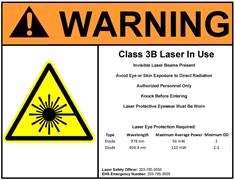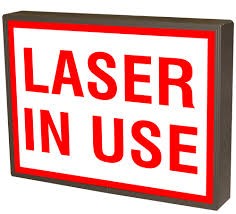Laser Safety Requirements
Required for all Class 3B (greater than 5mW up to 500 mW) and Class 4 (greater than 500 mW) laser controlled areas. These door signs are specific to the laser systems being used and are provided by EHS.
EXAMPLE:

Required for all Class 4 (greater than 500 mW) laser controlled areas.
EXAMPLE:

Laser protective eyewear is specific to the laser being used. Eyewear used for one type of laser may not provide appropriate protection for another. Contact the Laser Safety Officer at lasersafety@yale.edu to ensure that the correct eyewear is being used.
Appropriate laser eyewear meets the following conditions:
- Covers the wavelength(s) being used.
- Has an appropriate optical density (OD).
- Has a high enough visual light transmission (VLT) to allow the user to be able to see their surroundings while working. In general, the VLT should not be below 20 percent.
- Has the OD and wavelength range(s) covered physically inscribed on the glasses. This information cannot be present in a way that can be removed (i.e. written with marker or on a removable label). See an example.
- Are in good condition. Eyewear with cracks, holes, or broken parts should be disposed of and replaced.
Laser barriers are used to ensure that the laser light does not leave the laser controlled area. These include table top barriers, laser curtains and entryway barriers. Only approved laser barriers should be used (see examples). Laser barriers from a manufacturer go through a rigorous testing process to ensure that they can withstand laser light for a specified time period. Barriers will come with a threshold limit that shows the irradiance that the barrier can withstand for 100 seconds before the beam will penetrate through the barrier (ex. 100 W/cm2 for 100s). Barriers with appropriate threshold limits for your laser must be selected. For help with this, contact the Laser Safety Officer at lasersafety@yale.edu. If a non-tested, homemade barrier is being used, the Laser Safety Officer must be contacted to verify that the material being used is appropriate for the laser.
Alignment tools are available for when the user cannot see the beam through the laser protective eyewear. These tools include but are not limited to:
- UV and IR viewing cards
- IR cameras
- Zap-It alignment paper
- Low power (Class 3R) alignment lasers